Rail Baltica is the largest railway infrastructure project in the history of the Baltic States, which will build a fully electrified double-track European gauge railway connecting Warsaw, Kaunas, Vilnius, Panevėžys, Riga, Pärnu, and Tallinn. Now, Rail Baltica completes the next stage of the European railway gauge planning - specific solutions for the Kaunas railway node have been approved. The development of Kaunas Railway Station will include the construction of 1,435mm gauge main, arrival and departure tracks next to the existing Kaunas station building besides the relocation of 1,520 mm gauge tracks to the southern side of the station. A total of 120.8 km of railway tracks, 70 switches and 12 two-level railway and road intersections will be built or reconstructed. The entire railway section will be electrically-powered locomotives will run on it.
“The Kaunas railway node is one of the most important elements of Rail Baltica. It will be a major logistic centre, linking freight routes from North-West and Central Europe, as well as transit freight from the East and the Seaport of Klaipėda. This node is particularly important for the smooth handling of freight and passenger services, and we therefore give priority to its rapid development,” said Loreta Maskaliovienė, Deputy Minister of Transport and Communications.
As part of the construction of the Kaunas railway node, 5 new railway viaducts and 2 new bridges will be built and 5 existing bridges will be reconstructed. It is also planned to build a double-track railway tunnel near Palemonas station, to install 7 car tunnels for safe pedestrian and car movement, to reconstruct car viaducts and to establish pedestrian crossings.
Rail Baltica is also working with the European Commission to find solutions to meet environmental and infrastructure development priorities. “The development of this railway node, which is important for the Rail Baltica project, will boost the socio-economic growth of the whole region through the creation of new transport connections, the development of the necessary infrastructure, and the creation of new jobs. In addition, the spatial planning process focuses on environmental protection, as this section of the railway includes a Natura 2000 site,” added Dovydas Palaima, General Manager at LTG Infra Rail Baltica Management.

